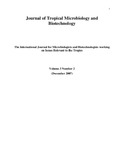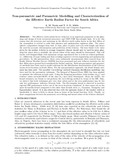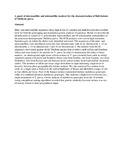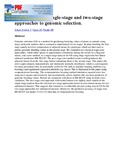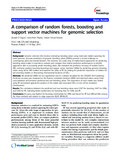Faculty of Science & Technology (FST): Recent submissions
Now showing items 1421-1440 of 4284
-
Characterization of East African Clays
(2005)A cross sectional study of 115 patients admitted at the Department of Orthopedics, Kenyatta National Hospital, Nairobi, Kenya was carried out to determine the prevalence and antibiotic susceptibility of Staphylococcus ... -
Concentration - dependent parsimonious releaser roles of gregarious male pheromone of desert locust, Schistocerca gregaria
(College of biological and physical sciences, 2008)The responses of (i) groups of crowd-reared mature males of desert locust, Schistocerca gregaria to a choice of two columns of air, one permeated with different concentrations of phenylacetonitrile (PAN), the major component ... -
Screening of Local Bacillus thuringiensis Isolates for Toxicity to Chilo partellus, Sesamia calamistis and Busseola fusca in Kenya
(2007)Stem borers are a major source of pre-harvest maize crop losses in Kenya and many Sub-Saharan African countries. This menace needs to be addressed if food security is to be realized in this region. Seven local isolates of ... -
Single and multi-component metal ion sorption on micaceous mineral of Kenyan origin
(College of biological and physical sciences, 2013) -
Phytochemical and Biological Studies of the Genus Croton for development of agrochemicals and Pharmaceutical Products
(University of NairobiCollege of Biological Sciences, 2007)Over the past two centuries, research into the chemical and biological properties of natural products has yielded novel and more effective therapeutic agents for treatment of many human ailments. There is, therefore, need ... -
"Non-Parametric and Parametric Modeling and Characterization of the Effective Earth Radius Factor for South Africa
(University of NairobiDepartment of Electrical, Electronic and Computer Engineering, 2013)The e®ective earth radius factor (k-factor) is an important parameter in the plan- ning and design of both terrestrial microwave and UHF/VHF line-of-sight links. It is for this reason that the structure and variations ... -
A panel of microsatellite and minisatellite markers for the characterisation of field isolates of Theileria parva
(College of Biological and Physical Sciences ,Department of Biological Science, 2003)Mini- and microsatellite sequences show high levels of variation and therefore provide excellent tools for both the genotyping and population genetic analysis of parasites. Herein we describe the identification of a panel ... -
Linkage disequilibrium between alleles at highly polymorphic mini- and micro-satellite loci of Theileria parva isolated from cattle in three regions of Kenya
(College of Biological and Physical Sciences ,Department of Biological Science, 2006)Theileria parva schizont-infected lymphocyte culture isolates from western, central and coastal Kenya were analysed for size polymorphism at 30 T. parva-specific variable number tandem repeat (VNTR) loci using a panel of ... -
Differential transcription of two highly divergent gut-expressed Bm86 antigen gene homologues in the tick Rhipicephalus appendiculatus
(College of Biological and Physical Sciences ,Department of Biological Science, 2011)The transcriptional control of gene expression is not well documented in the Arthropoda. We describe transcriptional analysis of two exceptionally divergent homologues (Ra86) of the Bm86 gut antigen from Rhipicephalus ... -
Release of intracranial pressure leads to improvement of otoacoustic emissions--a case report of a Kenyan child with complicated tuberculous meningitis
(College of Biological and Physical Sciences ,Department of Biological Science, 2013)Intracranial pressure usually is measured with invasive techniques. The usability of transient evoked otoacoustic emissions as non-invasive approach has been evaluated only once by Frank et al. This article presents the ... -
Diversity of lepidopteran stem borers on monocotyledonous plants in eastern Africa and the islands of Madagascar and Zanzibar revisited.
(University of NairobiSchool of Computing and Informatics, 2006)Surveys were completed in Eritrea, Ethiopia, Kenya, Madagascar, Mozambique, Tanzania, Uganda and Zanzibar to assess the lepidopteran stem borer species diversity on wild host plants. A total of 24,674 larvae belonging to ... -
Chemical analysis and in vitro UV-protection characteristics of clays traditionally used for sun protection in South Africa.
(University of NairobiDepartment of Chemistry, 2013)Clays have been used in southern Africa as photoprotectants by the indigenous people. Typically, two types of clay are used: one white in colour and the other red. In this work, the two clays were identified and characterized, ... -
Non-toxic melanin production inhibitors from Garcinia livingstonei (Clusiaceae).
(University of NairobiSchool of Computing and Informatics, 2013)The stem bark of Garcinia livingstonei is used traditionally as a skin lightening agent. AIM OF THE STUDY: To isolate and identify compounds responsible for the observed skin lightening activity of Garcinia livingstonei ... -
Sp1 sites mediate activation of the plasminogen activator inhibitor-1 promoter by glucose in vascular smooth muscle cells.
(University of NairobiSchool of Computing and Informatics, 1998)This study was designed to characterize the direct effects of hyperglycemia on plasminogen activator inhibitor-1 (PAI-1) expression in cultured vascular smooth muscle cells. Glucose induced dose- and time-dependent increases ... -
Rainfall influences on ungulate population abundance in the Mara-Serengeti ecosystem.
(University of NairobiSchool of Computing and Informatics, 2008)1. Rainfall is the prime climatic factor underpinning the dynamics of African savanna ungulates, but no study has analysed its influence on the abundance of these ungulates at monthly to multiannual time scales. 2. We ... -
Genomic selection using regularized linear regression models: ridge regression, lasso, elastic net and their extensions.
(University of NairobiSchool of Computing and Informatics, 2012)BACKGROUND: Genomic selection (GS) is emerging as an efficient and cost-effective method for estimating breeding values using molecular markers distributed over the entire genome. In essence, it involves estimating the ... -
Comparisons of single-stage and two-stage approaches to genomic selection.
(University of NairobiSchool of Computing and Informatics, 2013)Genomic selection (GS) is a method for predicting breeding values of plants or animals using many molecular markers that is commonly implemented in two stages. In plant breeding the first stage usually involves computation ... -
"Petrified ears" with idiopathic adult-onset pituitary insufficiency.
(University of NairobiSchool of Computing and Informatics, 2012)"Petrified ears" or calcification of auricular cartilage is an uncommonly reported condition. The most common causes of this phenomenon are local trauma, frost bite, and inflammation. Adrenal insufficiency is the most ... -
A comparison of random forests, boosting and support vector machines for genomic selection.
(University of NairobiSchool of Computing and Informatics, 2011)BACKGROUND: Genomic selection (GS) involves estimating breeding values using molecular markers spanning the entire genome. Accurate prediction of genomic breeding values (GEBVs) presents a central challenge to contemporary ...



